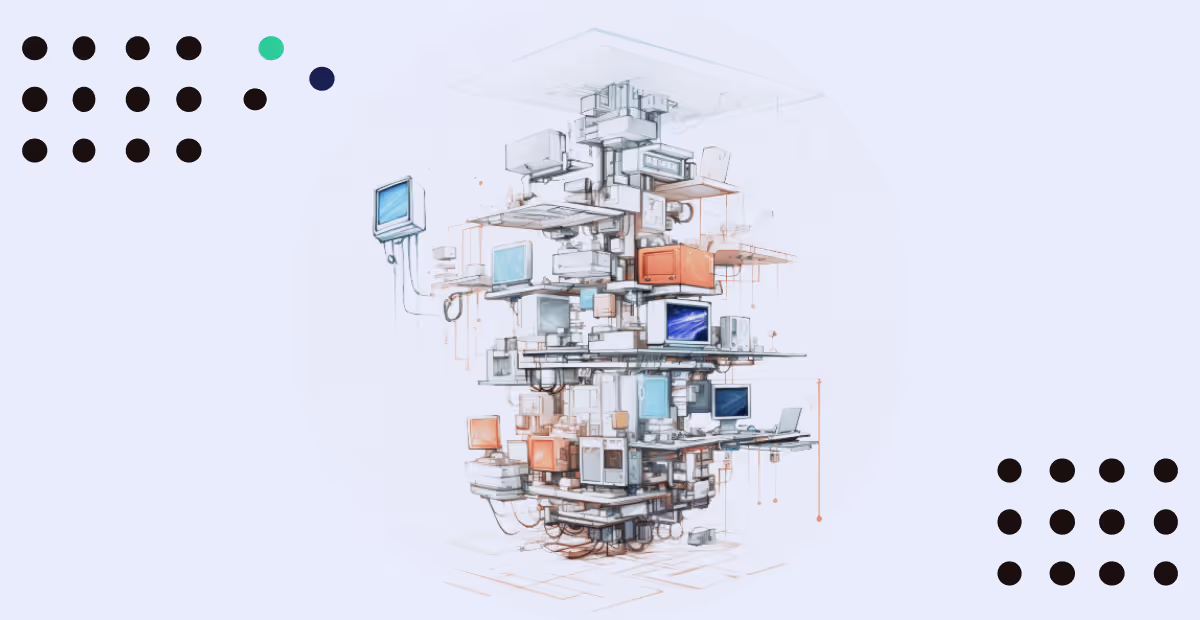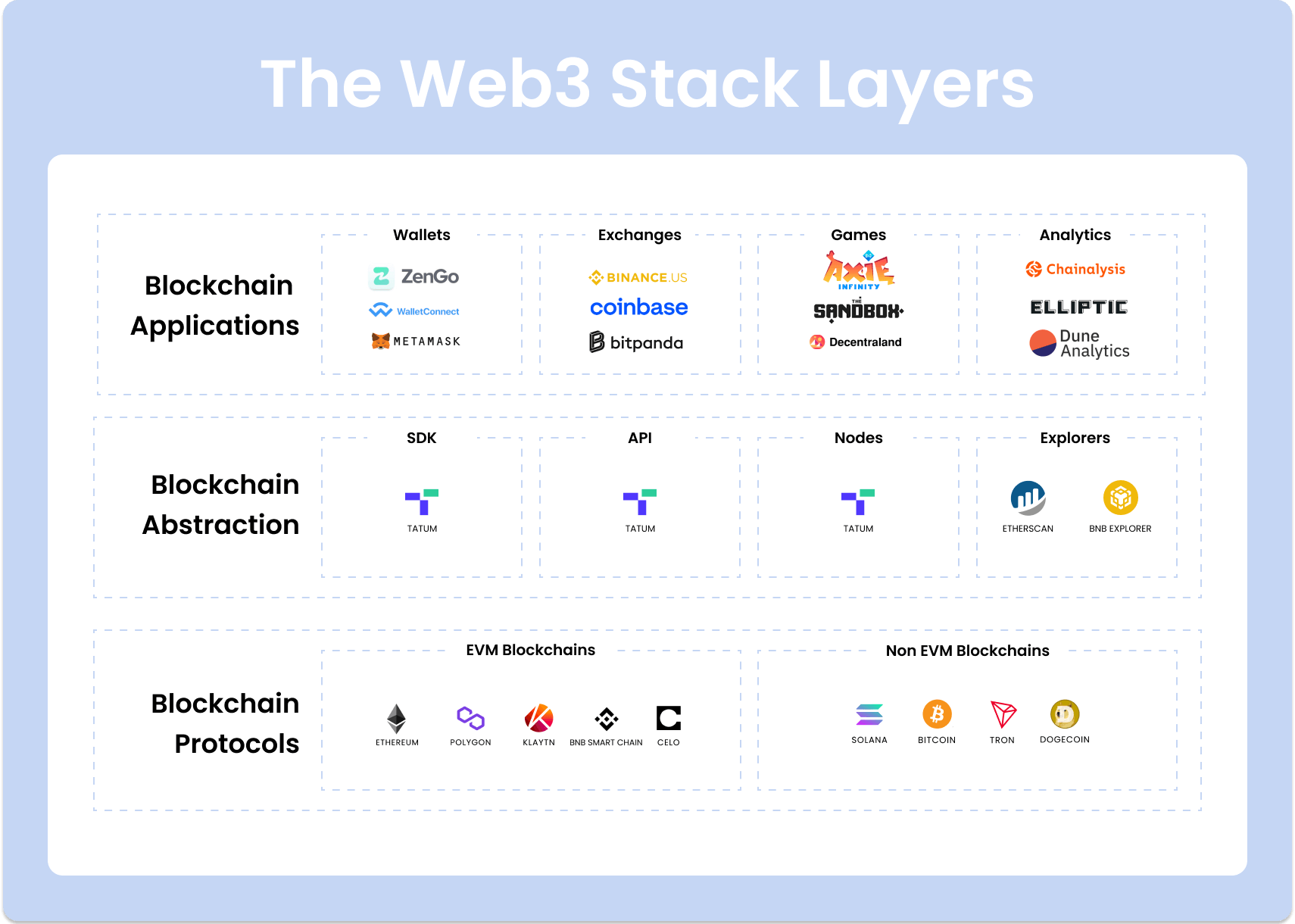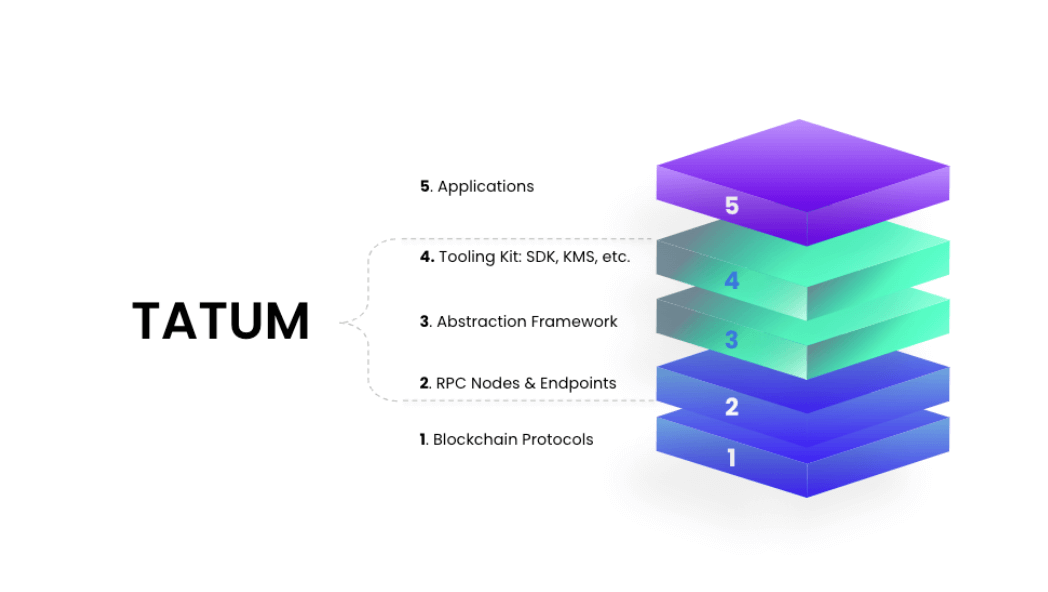Web3 Tech Stack: How to Build a Developer Full Stack for Growth



From the static pages of Web1 to the dynamic interactivity of Web2, we've witnessed the web's transition from an information portal to an integral part of our daily lives. Today, we stand at the threshold of the next step - Web3. Driven by the principles of decentralization, trustlessness, and peer-to-peer interactions, Web3 promises a future where users regain control over their data, applications are censorship-resistant, and intermediaries are minimized or eradicated.
For developers, this paradigm brings forth a new stack of technologies and methodologies to master. From blockchain protocols to decentralized file storage solutions, from smart contracts to token economies, the Web3 tech stack is vast and multidimensional. In this article, we'll delve into the components that define Web3, laying out a roadmap for developers eager to build their Web3 project.

Try Tatum APIs and SDKs for free. Speed up development, reduce code errors, and scale reliably.
[.c-wr-left][.c-copy-card][.c-copy-top][.c-copy-hex]npm i @tatumio/tatum[.c-copy-hex][.c-copy-top][$r-copy-to-clipboard=npm i @tatumio/tatum][.c-copy-icon][.c-copy-icon][$r-copy-to-clipboard][.c-tooltip]Copied![.c-tooltip][.c-copy-card][.button-blue-post]Get started[.button-blue-post][.c-wr-left]
The foundational layer of the Web3 tech stack is the blockchain network. In contrast to Web2 applications which lean on centralized databases, Web3 apps anchor themselves to blockchain infrastructures to ensure trustless and unrestricted access.
For developers venturing into decentralized application (dApp) creation, the landscape offers two main avenues: blockchains that are Ethereum Virtual Machine (EVM) compatible and those that aren't.
Ethereum has historically been the linchpin in Web3 development, offering a distinctive virtual environment known as the Ethereum Virtual Machine (EVM). It handles pivotal details, ranging from accounts to balances. Additionally, Ethereum's EVM governs a machine state, adjusting with every newly minted block based on the rules delineated by the EVM. Of key significance to developers, the EVM provides a structure for storing and executing smart contracts, enabling the coding of on-chain operations.
Recognizing the prominence of Ethereum and its EVM, several networks aspiring to address Ethereum’s scalability challenges and elevated transaction fees have chosen to build platforms in sync with the EVM. This translates to a universal software layer across EVM-compatible chains, primarily Solidity, to facilitate smart contract operations.
The merit of EVM-compatible blockchains is that they grant developers access to the wealth of tools, guides, and communities crafted for EVM ecosystems, streamlining the development process and ensuring cost-efficiency.
Ethereum: The archetype EVM platform for smart contracts.
Polygon: A sidechain linked to Ethereum.
Arbitrum: A Layer 2 network leveraging Optimistic rollups coupled with multi-round fraud verification.
Optimism: A Layer 2 network predicated on Optimistic rollups with a single-round fraud verification process.
Starknet: A ZK rollup Layer 2 solution powered by STARKs.
Avalanche: An EVM-aligned Layer 1 platform.
While Ethereum and its Ethereum Virtual Machine (EVM) have been pivotal in the realm of Web3 apps, many chains precede it and also additional layer ones have been built each with their own unique use cases. These non-EVM chains provide unique environments, offering different consensus algorithms, governance models, and tokenomics.
Although they may not natively support Solidity and might have distinctive ways of managing smart contracts and dApps, they bring to the table solutions to challenges faced by EVM chains, whether it's enhanced scalability, increased security, or alternative economic models.
One of the significant merits of non-EVM chains is the diversity they introduce to the blockchain landscape. Developers venturing into these ecosystems often find fresh tools, new communities, and different perspectives, enabling innovative solutions and broadening the horizons of decentralized applications.
Polkadot: A multi-chain interoperability platform allowing different blockchains to transfer messages and values.
Cosmos: With its Tendermint consensus, it seeks to achieve blockchain interoperability and scalability.
Tezos: A self-amending blockchain with on-chain governance and a unique baking (staking) model.
Flow: Designed for high-throughput applications, especially with a focus on games and digital assets.
Algorand: Offering instant transaction finality and built on a permissionless, pure proof-of-stake protocol.
Solana: Renowned for its high-speed and low-cost transactions, it uses a novel timestamp system called Proof of History.
Cardano: With its research-first approach, it emphasizes sustainability, scalability, and transparency.
Each of these non-EVM chains brings its own value proposition, architectural decisions, and technical nuances, offering developers a wide palette of options in the world of decentralized tech.
How do you ensure that your choice aligns with what’s needed for your app to function effectively? To answer this question, let’s take a look at how these blockchains differ.
Types of Blockchain Networks:
Federated Blockchain: Suited for organizations that collaborate on specific business processes.
Permissioned Blockchain: Allows certain actions by identified participants.
Private-permissioned Blockchain: Operates within an organization and requires specific permissions.
Permission-less Blockchain: A truly decentralized system where anyone can join and participate.
The application scenario, determined by the type of blockchain you're working with, is the primary factor for selection.
Tatum supports almost any blockchain you need to build a dApp and scale it. See the full list of supported blockchains.
Safety: Nodes must produce results in adherence to the protocol's regulations.
Participation: Active contribution from nodes during database modifications is essential.
Inclusivity: Ensure every node is involved in the decision-making or voting process.
Equitability: The consensus mechanism should grant equal significance to each node's vote.
Blockchain Forks: Suboptimal consensus algorithms can expose blockchains to vulnerabilities, leading to forks – a situation where a chain splits into multiple branches. This divergence can result in unpredictable application behaviors and split nodes.
Deteriorated Performance: An ill-fitted consensus mechanism can lead to node malfunctions or network partitioning. This, in turn, impedes the message-exchanging process, elevating latency and diminishing the overall performance.
In order to avoid locking yourself into the wrong blockchain, the best Web3 stack will offer you flexibility and allow you to switch chains if needed.
At its core, blockchain agnosticism promotes the idea of creating applications, solutions, or protocols that aren't tied to a specific blockchain but can operate across multiple chains. This principle resonates deeply with the overarching Web3 ethos of decentralization and interoperability.
Flexibility and Interoperability: Instead of being constrained by the idiosyncrasies and limitations of a single chain, agnostic solutions can leverage the strengths of multiple chains, seamlessly transitioning or interacting as required.
Risk Mitigation: Over-reliance on one blockchain exposes projects to potential vulnerabilities, bottlenecks, or systemic failures of that chain. Agnosticism provides a safety net, allowing operations to continue on alternative chains if needed.
Reaching a Wider Audience: Different blockchains have different communities. An agnostic approach enables projects to tap into diverse user bases, magnifying reach and adoption.
Future-proofing: The blockchain space is dynamic. Today's dominant chain might be overshadowed tomorrow. Building with agnosticism ensures your project remains relevant amidst shifts in the blockchain landscape.
In the previous chapter we discussed just how crucial it is for you to keep your stack flexible in order to maintain app continuity for your users. An essential among the tools of your Web3 stack that will allow you to do this are chain agnostic Software Development Kits (SDKs).
Yes, SDKs are essential in giving you flexibility to work easily across different chains, but an even more crucial factor why SDKs need to be a part of your Web3 stack are the programming ease and flexibility they provide to your app development.
Without SDKs, you or your team would have to learn the programming language of each chain and learn to interpret and work with the data provided by each chain. With an SDK, you can use common programming languages, like JavaScript to query blockchain data and easily, with tried and tested methods, integrate it into your application - an application that usually will use JavaScript. It reduces development time significantly and also makes blockchain development accessible to Web2 developers.
Consider this an integral layer of your stack. The stack layer that operates between the protocols and the app.

An alternative to using SDKs would be to query blockchains via a blockchain API.
Blockchain APIs (Application Programming Interfaces) are a set of routines, protocols, and tools that allow developers to fetch data, send transactions, or interact with smart contracts on a blockchain without having to deal with the intricacies of the underlying blockchain architecture. In essence, they provide a layer of abstraction, simplifying blockchain operations and making them more accessible to applications.
Simplicity and Accessibility: Developers without deep blockchain expertise can quickly integrate and interact with blockchain platforms, making the adoption curve less steep.
Cost-Efficient: Operating a full node can be expensive and resource-intensive. Blockchain APIs can mitigate this by offloading these tasks to third-party service providers.
Scalability: As your application grows, APIs can handle increased loads, ensuring that performance remains optimal.
Cross-chain Interactions: Some blockchain API providers offer services across multiple chains, facilitating easier cross-chain development and integration.
Up-to-date Data: API providers usually maintain updated nodes, ensuring developers have access to the latest blockchain data without manual updates.
Data Retrieval: Fetching transaction details, block information, or contract events.
Sending Transactions: Creating and broadcasting transactions on the blockchain.
Smart Contract Interaction: Executing methods on deployed smart contracts.
Wallet Services: Some APIs offer wallet functionalities, facilitating the creation, management, and querying of crypto wallets.
In the decentralized landscape, two primary tools allow applications to communicate and interact with blockchains: Blockchain APIs and Software Development Kits (SDKs). While they both serve as bridges, their approach, functionalities, and use cases differ in notable ways.
Blockchain APIs: APIs are essentially sets of predefined methods that allow external applications to interact with the blockchain. They work as intermediaries, fetching, or sending data on behalf of the application.
SDKs: An SDK is a collection of software tools, libraries, relevant documentation, code samples, processes, and guides that allow for the development of applications. While SDKs may incorporate APIs, they provide a more comprehensive set of tools for a specific platform or application.
Blockchain APIs: APIs require developers to make calls to external services to fetch or send data. This might introduce external dependencies and potential points of failure.
SDKs: While often more complex and requiring deeper integration, SDKs can offer a more seamless and consistent experience. They provide developers with greater control over the interaction process, often resulting in more tailored solutions.
Blockchain APIs: Since API calls are essentially requests to external servers, they might introduce latency, especially under high loads or due to network issues.
SDKs: By being deeply integrated into the application, SDKs can often offer better performance and reduced latency, especially if operations are handled locally.
Blockchain APIs: Often designed for a specific set of tasks (like fetching data, sending transactions), making them great for specific functionalities without the overhead of additional features.
SDKs: Typically broader in scope, providing tools, libraries, and functionalities for a wide array of tasks, which can be especially useful for complex applications or platforms.
Blockchain APIs: Maintenance is primarily on the provider's side. If the API provider updates or modifies the service, it might require changes on the developer's end to maintain compatibility.
SDKs: Developers have a more active role in updating and maintaining SDK integrations. While this means more control, it can also mean more responsibility for keeping things up-to-date.
At the heart of every blockchain network lies a fundamental component: the node. Without nodes, blockchains wouldn't function. Here's a primer on what blockchain nodes are and why they're crucial.
In the simplest terms, a blockchain node is a computer running the software that participates in the network, upholding its decentralized nature. These nodes collectively store, disseminate, and verify the data held within the blockchain.
Full Nodes: These nodes store the entire history of the blockchain and can independently validate every transaction and block. They're crucial for security and decentralization.
Light Nodes (or SPV Nodes): Light nodes store only a subset of the blockchain. They rely on full nodes for more detailed information and are generally quicker and require less storage.
Mining Nodes (or Validator Nodes): Specific to proof-of-work (PoW) and some other consensus mechanisms, these nodes perform the computational work needed to secure the network and add new blocks.
Archival Nodes: These store the complete historical state of the blockchain, not just the transaction history, making them useful for deep historical queries.
With Tatum you can access any node you need and get started for free.
Nodes are the backbone of a blockchain network, playing a multifaceted role. The more nodes present, the greater the decentralization, reducing vulnerabilities to centralized control or single points of failure. They validate and relay transactions, guaranteeing that only those adhering to network rules proceed. Simultaneously, by each node storing a blockchain copy, data integrity and availability are ensured, even in cases of individual node failures. Furthermore, nodes collaboratively partake in the consensus mechanism, maintaining a consistent state across the blockchain network.
Managing a node directly can be complex and resource-intensive. It requires a deep understanding of the blockchain infrastructure, significant computational resources, and constant maintenance to stay updated with network changes. As an application scales, directly querying a node might introduce latency and the challenge of keeping up with multiple blockchains becomes cumbersome.
On the other hand, SDKs streamline this process by abstracting many intricacies. They offer optimized, pre-built functions that can handle higher loads, interact seamlessly with multiple chains, and reduce development time.
Additionally, SDKs handle errors gracefully, provide redundancy, and often ensure faster responsiveness by choosing the most efficient node to query.
Blockchain explorers are web-based tools that provide an interface to view and search transactions, addresses, blocks, and other activities on a blockchain network. Acting like a search engine for blockchains, they offer transparency by allowing anyone to verify transactions, check wallet balances, and understand the state of the network in real-time, making the decentralized ledger's data accessible and comprehensible to both technical and non-technical users.
For developers and users of decentralized applications (dApps), a blockchain explorer is indispensable. It provides clarity and transparency in tracking on-chain actions triggered by the dApp, verifying smart contract deployments, and debugging transaction issues.
In the world of Web3, smart contracts are the foundation of decentralized applications, automating and encoding complex logic on the blockchain. Developing, testing, and deploying these contracts, however, requires specialized tools designed to handle their unique characteristics. Here are some notable platforms:
Truffle: An established development environment, testing framework, and asset pipeline for blockchains. It offers a suite of tools to write, deploy, and test smart contracts using the Solidity programming language, making the development process streamlined and efficient.
Hardhat: A newer entrant in the space, Hardhat prioritizes developer experience with features like stack traces, console.log functionality, and a built-in development network. Its flexible plugin system also ensures adaptability to a variety of tasks.
Remix: A powerful, open-source tool that operates directly in the browser, Remix is ideal for quick prototyping and debugging. It provides an integrated development environment with features like a Solidity editor, debugger, and a test blockchain environment.
In the Web3 ecosystem, wallets like MetaMask and WalletConnect are paramount, serving as bridges between users and decentralized applications (dApps). These wallets store cryptographic keys, enable digital asset transactions, and importantly, allow users to seamlessly interact with dApps—authenticating actions, confirming transactions, and ensuring a user-friendly decentralized experience.
There are a multitude of ways how wallets can be integrated into your dApp. Tatum.io provides a seamless way to add a wallet to your site through it’s SDK simply using JavaScript. Read more about this on Tatum documentation.
Oracles play a critical role in the Web3 ecosystem, serving as intermediaries that feed real-world data to on-chain smart contracts. Services such as Chainlink and Band Protocol stand out in this domain, enabling smart contracts to access external information, like price feeds, weather data, or other off-chain events. By bridging the gap between on-chain and off-chain environments, oracles amplify the applicability and utility of decentralized applications across diverse sectors.
The traditional centralized data storage models pose challenges in terms of censorship, central points of failure, and potential data breaches. Decentralized storage solutions aim to redefine data storage by leveraging blockchain principles. IPFS (InterPlanetary File System) stands out by offering a peer-to-peer hypermedia protocol designed to make the web faster, more secure, and open. Complementing IPFS, Filecoin acts as its incentivization layer, rewarding nodes for storing and retrieving files.
Storj takes a different approach, decentralizing cloud storage to protect against data breaches and ensure data privacy. By splitting files into encrypted fragments and distributing them across a network of nodes, Storj ensures data remains secure and accessible. Both these systems exemplify how decentralized applications (dApps) can store data off-chain, ensuring data's integrity and availability without compromising on decentralization.
In the rapidly evolving world of decentralized applications (dApps) and blockchain networks, understanding user behaviors, transaction patterns, and network health becomes paramount.
Analytics and monitoring tools bridge this knowledge gap by offering invaluable insights into the intricate workings of the decentralized web. Platforms like Chainalysis, Dune Analytics, Elliptic present an avenue for professionals to dive deep into blockchain data, providing visualizations and analyses that highlight dApp interactions, token transfers, and smart contract executions.
The Web3 stack presents a transformative blueprint for building a decentralized digital future. From the foundational role of blockchains and nodes to the nuances of smart contract platforms, storage solutions, and analytics tools, every component harmoniously converges to redefine our interactions online. As we venture deeper into this decentralized era, understanding and leveraging this stack becomes essential for developers, innovators, and visionaries. By embracing the tenets of transparency, decentralization, and community-driven governance, Web3 promises not just a technological shift, but a societal evolution towards a more inclusive and empowered digital landscape.
Build blockchain apps faster with a unified framework for 60+ blockchain protocols.